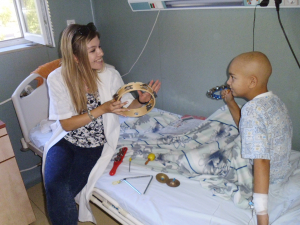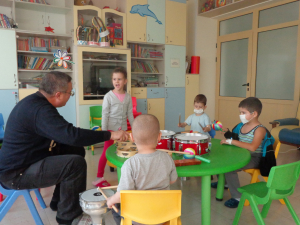
ARTON PROGRAM - The therapeutic power of the group
Creative projects involving group work - general musical performance or group painting, collage, sculpture - are useful in helping to explore and strengthen social...
No one likes dealing with conflict. But no matter how hard we try to avoid them, arguments, fights and disagreements are a fact of life — for adults and for kids. And not dealing with conflicts when they arise can negatively impact relationships and lead to further interpersonal challenges down the road.
Conflict may not be pleasant, but it doesn’t have to feel catastrophic. Teaching kids practical skills to manage it in a healthy way will help them navigate everything from small squabbles (“She took my doll!”) to big issues (“I don’t know if I want to be your friend anymore”) both now and as they grow up.
Part of what makes conflicts difficult to navigate is the way they bring out big, intense emotions that children may not have the tools to process. Before they can address the problem that caused the conflict — whether it was a fight over a toy or betrayal by friend — kids need to be able to get to a place emotionally where they can think before they act (or lash out and make things worse).
Parents can start by helping kids identify the emotions they’re having. Are they feeling anger? Frustration? Hurt? Embarrassment? Stephanie Lee, PsyD, a child psychologist at the Child Mind Institute, and Carey Werley, LCSW, a clinical social worker at the Child Mind Institute, recommend using visual tools to help little kids identify what they’re feeling.
When emotions are still intense, it’s not the right time to problem-solve about the conflict itself. Help kids come up with a toolbox of coping skills to use if they need to calm down in the heat of the moment. This might mean splashing cold water on your face, taking some deep breaths or playing with a pet.
Once big emotions have cooled down, the next step is figuring out exactly what the problem is. Sometimes kids, especially younger ones, don’t have the emotional awareness to identify the original source of the conflict. They might need your help to understand why they’re fighting. For example, if your child and their friend are squabbling over a toy, the issue might be much deeper, explains Werley. “It could actually be that one of them made a new friend and the other feels left out,” she says.
Helping kids get to the root of the issue will make it easier for them to resolve what’s actually wrong. It will also give them tools to identify and talk about similar problems when they come up again. Older kids starting in grade school and middle school are more likely to have the language to identify the source of the conflict, so with a little guidance they can learn to use these skills independently going forward.
Once kids understand what the issue is, you can help them practice finding solutions. Little kids in particular will need a grown-up’s guidance here, but even older kids and teenagers can benefit from having someone to bounce ideas of off.
For any age, Dr. Lee suggests brainstorming several solutions then putting your heads together to pick the best one. For younger kids, she recommends a couple of ways to structure this conversation:
Problem-solving baseball: This exercise takes kids through the processing of thinking up and evaluating possible action plans. “I have kids pitch me a problem and then we go through the bases,” Dr. Lee explains. “So, first base is what’s my problem? Second base is what are some potential options? Third base identifies the best options. And home plate is, am I safe or out? Did I pick the right one? The object is to help even very young kids start to understand what is going to get them closest to their goal.”
Of course, the tricky thing here is that it’s usually hard to know what the best option really is. And that’s okay! Let kids know that the goal is to make your best effort, not to solve everything perfectly right away. They might have to go back to the drawing board if their first plan doesn’t pan out — often, that’s just part of the process. “You also want to jump in and praise your child for trying those skills even if things didn’t work out as they had hoped,” says Dr. Lee. “Give them credit and then help them navigate from there. And when they do figure it out, make a big deal out of that.”
Conflicts often feel enormous and immediate, which can make it hard to keep perspective on the situation. To find useful solutions, it’s important for kids to practice taking a mental step back. A few tips you can encourage kids to keep in mind include:
In order to resolve a conflict, kids need to learn to communicate their feelings clearly, without lashing out or making accusations. It’s tough to practice communication skills when tensions are running high, so consider talking over these skills with kids when they’re not already in the midst of a conflict. Then, you can provide gentle reminders and guidance when things do get heated. Werley and Dr. Lee recommend the following strategies:
One of the most powerful things you can do to help your child learn conflict resolution is to show them how it’s done. When you experience a conflict of your own (especially one with your child!), put the techniques described here into practice. When appropriate, you can even talk your child through how you solved the conflict. Seeing you succeed — and make mistakes along the way! — shows kids that solving conflicts really is doable, even when it’s hard.
Article re-posted from https://childmind.org/

Creative projects involving group work - general musical performance or group painting, collage, sculpture - are useful in helping to explore and strengthen social...

In the ARTON Program our team of oncopsychologists, art therapists and music therapists develops the process of children's creativity as a process of...

In ARTON sessions, creating a piece of music or a song is an emotional experience of coping and satisfaction for the participating children. They make friends with...

Painting provides patients with a spontaneous, plastic method of depicting thoughts and experiences. Painting with paints is not as structured as with pencil or...










